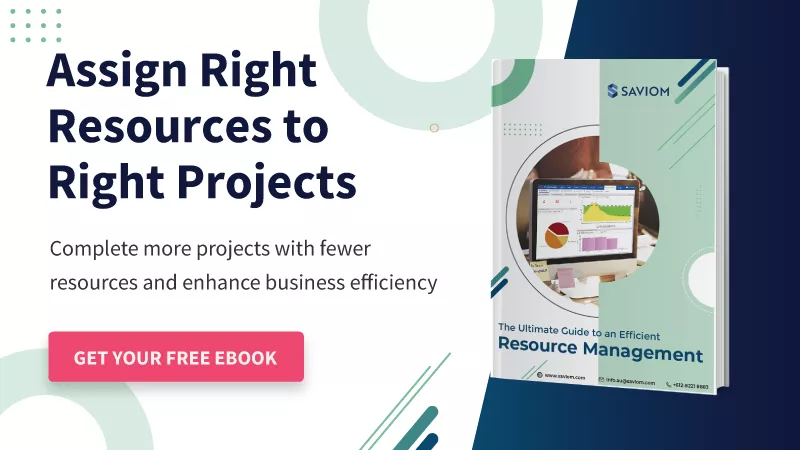The professional services sector is well-established over the years and covers numerous industries, from IT and marketing to law and accounting. Human resources being the most vital asset plays a significant role in revenue generation activities for these firms due to their knowledge base. Consequently, there is also a constant pressure on the professional services consultants to upgrade their expertise and skills with the growing technology trends.
An effective workforce planning process can fuel the adaptability of companies to adjust to market conditions quickly. Capacity planning is a scientific process to assess their current and future workforce demand and proactively take necessary action.
The traditional paradigm of resource planning leads to guesstimate without proper insight into future requirements. A modern capacity planning solution gives an indication of current and future requirements and allows firms to make data-driven informed decisions. It not only contributes in determining the capacity and demand gap but also helps to identify appropriate resources within professional service companies in advance.
This article will cover some critical factors to scale up the capacity planning strategies and also explains the essential benefits of resource capacity planning.
Let’s begin with understanding the characteristics of PS firms in detail.
What are the salient features of a professional services firm?
Professional service firms are considered service-based businesses that cover several service types: business consulting, accounting, law, advertising, IT solutions, architecture, engineering, recruitment, financial services, marketing public relations, research, and so on.
These firms also maintain a healthy client base, differentiate their services from the competition to win work, retain the best talent pool, and deliver organizational profitability.
Here are some salient features of a professional services firm:
Resource-based
Professional service businesses are fundamentally about human resources, as they are the greatest asset of the company and provide knowledge-based services. Therefore, these firms acquire a highly specialized workforce from the competitive market and make them billable.
Billable utilization is one of the most critical KPIs for professional service firms. For instance, It is calculated as resource hours spent on billable client work divided by the number of hours in a week, i.e., Full-Time Equivalent or 1 FTE.
According to SPI, “Maintaining high utilization of resources drives higher billings, revenue, and profits to an organization.”
Client-focused
Professional services firms place an enormous emphasis on the needs of their clients or are client-focused. For them, the client is always the king, as they provide commercial stability to many organizations. By delivering top-notch service aimed directly at the requirements of their clients, a company will see a simultaneous rise in business performance.
Higher service rates and profitability
Like any business, multiple factors influence the pricing strategy of professional service firms – market needs, competition, service model, brand value, company command, etc. Usually, profit margins for well-run professional services firms can be 10% to 20% or more, which yields relatively high cash flow and revenue in an organization.
Shorter assignment model
New deals and repeat business from existing clients are the fundamental pillars of growth for the professional services industry. They provide the knowledge and skills of their employees, often on an assignment basis, where a specific resource or team is responsible for delivering services to the client. It is usually for a shorter duration, and resources are generally charged hourly.
Read More: 5 Professional Services trends to watch out for
Now that we know the features of PS firms, let’s understand how capacity planning can benefit professional service firms here.
Benefits of capacity planning in professional services firms
An advanced capacity planning solution provides managers with foresight into workforce capacity. Using these insights, they can tap into the right potential and allocate the right resources to the right job.
Here are the benefits of capacity planning that aid professional service firms:
Empower resource/project managers
Today, capacity planning is an integral part of the core resource management process. The planning empowers both resource managers and project managers with enterprise-wide visibility of the resource pool. After analyzing the demand skills gap, they then make decisions based on capacity information.
Moreover, this foresight into capacity and demand for future projects helps resource managers proactively implement various resourcing treatments, manage work, and enhance productivity.
Forecast pipeline projects proactively
With today’s professional service business challenges, it’s no longer appropriate to allocate resources to tasks impromptu. Managers have to be more strategic in forecasting pipeline projects and estimating project resource requirements in advance.
This aids managers with proactive measures to bridge the demand difference. In case of a shortfall of resources, they can select any competent benched resource or hire a permanent/contingent workforce with the right skill set. Whereas for excess resources, they can bring future work ahead or redeploy resource capacity in other projects.
Therefore, forecasting and capacity planning help reduce last-minute hiring activities, which can lead to cost escalation and compromised work quality.
Leverage the right talent on various projects
Resource capacity planning aims to allocate resources to work efficiently. With the right people doing the right work, managers prevent under or overutilization of resources and help in improving employee satisfaction.
Using an intuitive resource management solution, managers lead strategic workforce planning practices such as acquiring low-cost global resources, hiring on-demand resources, out rotation of niche resources, etc. These practices help to drive organizational results with the most vital asset- the people.
Facilitate effective bench management
With effective capacity management, managers can foresee resources that will land up on the bench and allocate them to suitable project vacancies accordingly. Enterprise-wide visibility into the available skills allows them to quickly assign these resources to project tasks, thereby reducing bench strength. Benched resources can also be made billable by providing training on the job or shadowing opportunities.
Align sales and delivery of projects within time and budget
The right capacity planning measures ensure all project resource requirements are identified and fulfilled. It is also revisited throughout the project life cycle as resource demand fluctuates from time to time. Real-time data and regular monitoring of projects and resources are essential to align sales and delivery within a specified budget and time.
Read More: 5 Best Practices for Capacity Management
The benefits of capacity planning are substantial. Let’s now look at some of the critical factors that support a better capacity planning process.
Critical factors for better capacity planning
Hiring is an important activity for professional services companies. They can not depend too much on contingent resources due to skill set requirements. Many professional services companies also have a policy of taking fresh graduates and training them as per their business demands. At the same time, the shortage created by unplanned attrition also needs to be replenished. Both over and under-capacity are bad for profitability and must be carefully analyzed and planned.
To be competitive and effective within an industry, all firms need to ensure it has the right resource pool that helps promote success. With appropriate capacity plans in place, managers can foster a conducive work environment to achieve client-focused results.
Listed below are the five critical factors that will help to better professional services capacity planning practices in place:
Historical data & future trends
Resource Managers and Project managers can collaborate and create a resource plan by examining both past data and upcoming future trends. For example, if the company turnover grew 15 percent last year, they can plan to build 15 percent more resource capacity this year. This will create a process where managers will periodically review/revisit business objectives and plan for future resources well in advance.
Strategize with what-if scenarios
It’s not common for a professional service company to have multiple business models and complex project environments. Therefore with robust resource capacity planning tools, managers can simulate numerous scenarios and predict future outcomes with accuracy. Using data-driven actionable insights, managers can select the best result under the given constraints and apply it to a real project plan.
For example, when planning to hire 20 new engineers to tackle a significant project or reduce marketing resources by 15 percent, managers can better overview all future outcomes through a what-if scenario. It will help them create a more accurate capacity plan.
Read More: What is Resource Capacity Planning? An Ultimate Guide for Every Project Manager
Resource factor
As mentioned before, resources are an essential part of any professional service firm. Hence they can be effectively managed by using a multidimensional resource scheduler. The tool helps managers get a comprehensive view of all resource-related information, such as skill sets, cost rate, location, and resource capacity, among others. Using appropriate filters, managers can allocate competent resources to the specific project’s task.
In addition to human resources, companies should also understand how business performance draws on infrastructure resources as well. For example, Suppose a firm expects a marketing initiative to drive 50,000 sales in the coming year. In that case, managers can use this information to determine how much more inventory assets, like storage devices, computers, etc., would be required in advance.
Operational factors
Effective professional services capacity planning is the foundation that impacts business processes and management essentially. Finance management, stakeholder management, risk management, change, and dependency management are some of the operational factors that affect the project’s progress and success.
Therefore, managers need to regularly revisit the planning process and manage the project lifecycle to avoid bottlenecks down the road.
Having a central source of real-time data lets a project management office (PMO). standardize processes, and generate best-practice metrics for delivering high-quality projects.
Budget and timeline
Capacity planning helps businesses to complete project needs within budgetary and timeline constraints. For each phase of the project, managers first need to estimate both limitations. The budgetary constraint may include human resource costs, equipment/assets procurement costs, and operational costs (licenses, material costs).
Thus, managers need to monitor the variance between the planned budget vs. actual spending and timeline as they are the baseline to measure project performance.
Read More: Project Resource Management: An Ultimate Guide on How to Master it
Conclusion
A robust, advanced, and comprehensive capacity planner is pivotal in utilizing the talent pool to its best extent. When a resource manager has 360-degree visibility of the resources and their skills, they can make capacity and demand planning decisions. It can be backed by data instead of speculation and avoid potential pitfalls.
The tips mentioned above will help scale up your capacity management plan and help futureproof the workforce within a professional service firm. Additionally, these tips will enable managers to empower their decision-making, enhance productivity, and manage resources efficiently.
What challenges do you face in implementing capacity planning strategies in your organization?
The Glossary
Read More: Glossary of Resource Workforce Planning, Scheduling and Management
SAVIOM Solution
SAVIOM is the market leader in offering the most powerful and configurable solutions for managing enterprise resources efficiently and effectively. Having more than 20 years of experience, this Australian-based MNC has a global presence in over 50 countries. It is also popular with more than 100 customers and helping them to achieve their business goals. SAVIOM also has products for project portfolio management, professional service automation, and workforce planning software which can be easily customized as per business requirements.












